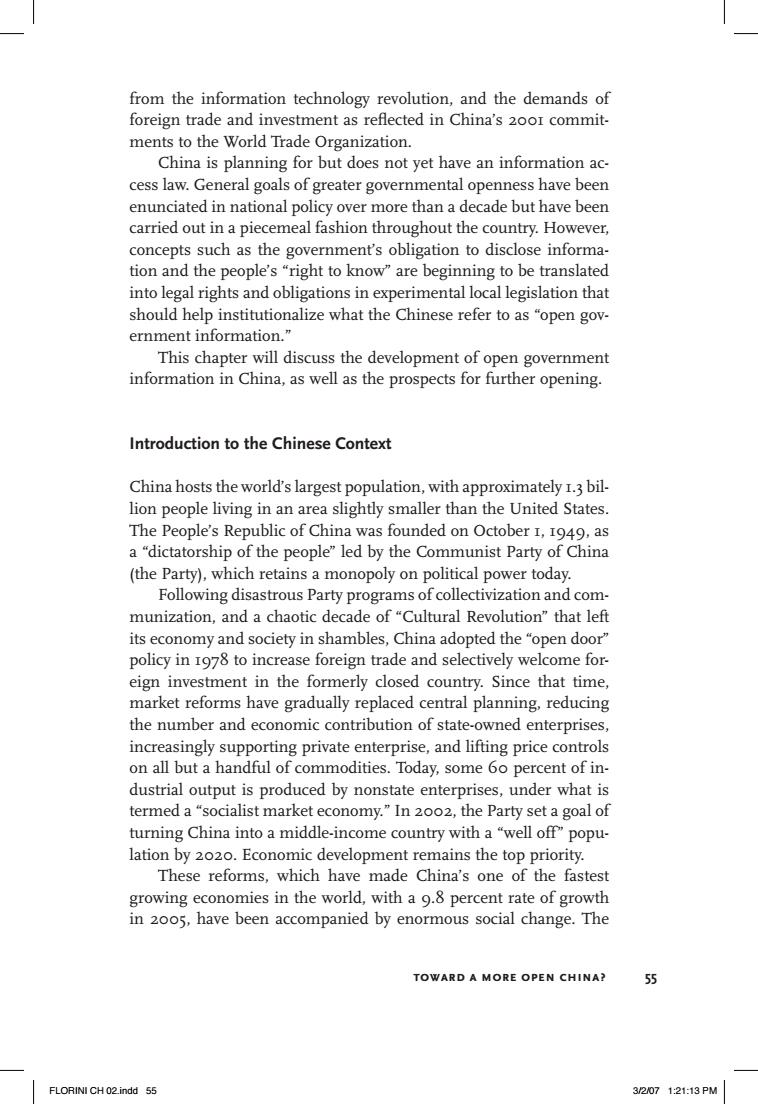正在加载图片...

from the information technology revolution,and the demands of foreign trade and investment as reflected in China's 2ooI commit- ments to the World Trade Organization. China is planning for but does not yet have an information ac- cess law.General goals of greater governmental openness have been enunciated in national policy over more than a decade but have been carried out in a piecemeal fashion throughout the country.However, concepts such as the government's obligation to disclose informa- tion and the people's"right to know"are beginning to be translated into legal rights and obligations in experimental local legislation that should help institutionalize what the Chinese refer to as "open gov- ernment information." This chapter will discuss the development of open government information in China,as well as the prospects for further opening. Introduction to the Chinese Context China hosts the world's largest population,with approximately 1.3 bil- lion people living in an area slightly smaller than the United States. The People's Republic of China was founded on October I,1949,as a "dictatorship of the people"led by the Communist Party of China (the Party),which retains a monopoly on political power today. Following disastrous Party programs of collectivization and com- munization,and a chaotic decade of"Cultural Revolution"that left its economy and society in shambles,China adopted the "open door" policy in 1978 to increase foreign trade and selectively welcome for. eign investment in the formerly closed country.Since that time, market reforms have gradually replaced central planning,reducing the number and economic contribution of state-owned enterprises, increasingly supporting private enterprise,and lifting price controls on all but a handful of commodities.Today,some 6o percent of in- dustrial output is produced by nonstate enterprises,under what is termed a "socialist market economy."In 2002,the Party set a goal of turning China into a middle-income country with a"well off"popu- lation by 2020.Economic development remains the top priority. These reforms,which have made China's one of the fastest growing economies in the world,with a 9.8 percent rate of growth in 2005,have been accompanied by enormous social change.The TOWARD A MORE OPEN CHINA? 55 FLORINI CH02indd 55 3/2071:21:13PMfrom the information technology revolution, and the demands of foreign trade and investment as reflected in China’s 2001 commitments to the World Trade Organization. China is planning for but does not yet have an information access law. General goals of greater governmental openness have been enunciated in national policy over more than a decade but have been carried out in a piecemeal fashion throughout the country. However, concepts such as the government’s obligation to disclose information and the people’s “right to know” are beginning to be translated into legal rights and obligations in experimental local legislation that should help institutionalize what the Chinese refer to as “open government information.” This chapter will discuss the development of open government information in China, as well as the prospects for further opening. Introduction to the Chinese Context China hosts the world’s largest population, with approximately 1.3 billion people living in an area slightly smaller than the United States. The People’s Republic of China was founded on October 1, 1949, as a “dictatorship of the people” led by the Communist Party of China (the Party), which retains a monopoly on political power today. Following disastrous Party programs of collectivization and communization, and a chaotic decade of “Cultural Revolution” that left its economy and society in shambles, China adopted the “open door” policy in 1978 to increase foreign trade and selectively welcome foreign investment in the formerly closed country. Since that time, market reforms have gradually replaced central planning, reducing the number and economic contribution of state-owned enterprises, increasingly supporting private enterprise, and lifting price controls on all but a handful of commodities. Today, some 60 percent of industrial output is produced by nonstate enterprises, under what is termed a “socialist market economy.” In 2002, the Party set a goal of turning China into a middle-income country with a “well off” population by 2020. Economic development remains the top priority. These reforms, which have made China’s one of the fastest growing economies in the world, with a 9.8 percent rate of growth in 2005, have been accompanied by enormous social change. The toward a more open china? 55 FLORINI CH 02.indd 55 3/2/07 1:21:13 PM